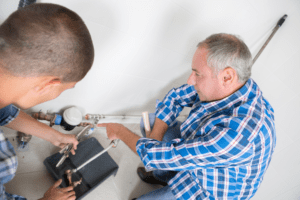Part of responsible space management is knowing some details about how your central heating system works. Whether for a house or an office, the same concepts hold sway, but the size and layout of the building have a significant impact. One of the main reasons to know how a central heating system works in a house is to ensure its effective function. Several signs indicate you may need service.
One of the best approaches to central heating is forced air, as it’s an effective and powerful way to heat a building, and is as true for a multi-building office complex as it is for a single-family home. In either case, you need to watch out for any warning signs that your system may require maintenance and reap the rewards of warm, comfortable air.
Recognizing How a Central Heating System Works in a House to Know When You Need Service
 You don’t need to know all the mechanical details about how a central heating system works in a house to have a good idea of when you should call a service technician. Rather than that, there are two areas that you can focus on to remain in tune with your system and ensure it functions at peak performance: temperature control and air quality.
You don’t need to know all the mechanical details about how a central heating system works in a house to have a good idea of when you should call a service technician. Rather than that, there are two areas that you can focus on to remain in tune with your system and ensure it functions at peak performance: temperature control and air quality.
Temperature control is the obvious indicator for a good reason: if your air temperature is not hot enough when your system is running, there is a problem. To diagnose where the problem is, there are several things you need to check. First, see if there is air coming out of the air vents. If there is, but the temperature is relatively cool, then there’s an issue with the furnace itself. If there isn’t air, however, there are several potential causes. The first could be that there’s a blockage in the ducts. Another likely cause could be the furnace not firing, or the blower malfunctioning.
If the air is flowing, and the temperature is correct, then other common issues are related to air quality. The HVAC filters must be changed regularly; otherwise, dust and other buildups can accumulate in the ducts. If this occurs, your air quality will suffer, leading potentially to a stale scent, mold growth, and the distribution of allergens that may be problematic particularly for those with asthma.
System Focus: How a Gas-Powered Forced Air System Works
The common issues that a forced air central heating system may face allude to the structure of the system. The major components to this kind of system are a furnace, fuel, blower, ducts, vents, filters, and intakes. Each part performs a specific function:
- The furnace is the heart of the machine. It takes the fuel and combusts it to heat air, then sends it to the blower. Without the furnace, there’s no hot air.
- There are several fuel sources that you may find associated with forced air systems. The two most common these days are gas and oil. Oil heat was more common in past decades, but it is falling out of favor due to the wide availability of natural gas lines and the pains of working with a 300+ gallon oil tank.
- The blower takes the hot air from the furnace and sends it into the duct system. When this is functioning properly, it propels air throughout your home or office to ensure that heat makes it to each room.
- The ductwork runs from the furnace (usually located in a basement) throughout your building, and is often a significant expense for buildings that are installing a new system, but once installed, the ducts require little maintenance other than scheduling routine cleanings.
- The vents (also called registers) are the exhaust points for the ducts. There should be at least one in each room, unobstructed so that heat is distributed through each room in the building. During the winter, if you can reduce the number of rooms used in your home, you can close the vents to them and shut the door tightly. Closing off rooms will limit the hot air to the remaining space, thus decreasing your expenses and easing the burden on your central heater.
- The filters and intakes work in tandem to resupply air to the furnace, which not only keeps the furnace fed with air to heat and distribute, but also allows for the pressure to be kept constant rather than building up to uncomfortable levels in the rooms you’re heating.
Maintaining Your Central Heating System in Good Working Order
Armed with this knowledge, you’re now better equipped to notice when your system is not functioning properly. With a few easy checks, you can narrow down the potential trouble spots for your system and save time and hassle with HVAC maintenance. Ultimately, knowing how a central heating system works in a house is not merely academic, but part of responsible homeownership.

